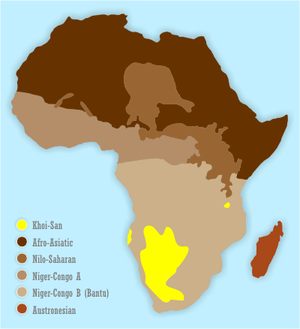
Back Khoisan-tale Afrikaans खोइसन भाषाएं ANP لغات خويسان Arabic Llingües de la familia khoisan AST خویسان دیللری AZB Койсански езици Bulgarian খোইসীয় ভাষাসমূহ Bengali/Bangla Yezhoù koiek-sanek Breton Llengües khoisànides Catalan Kojsanské jazyky Czech
| Khoisan | |
|---|---|
| Khoesaan | |
| (obsolete) | |
| Geographic distribution | Kalahari Desert, central Tanzania |
| Linguistic classification | (term of convenience) |
| Subdivisions | |
| ISO 639-2 / 5 | khi |
| Glottolog | None |
 Map showing the ancestral distribution of the Khoisan languages (yellow) | |
The Khoisan languages (/ˈkɔɪsɑːn/ KOY-sahn; also Khoesan or Khoesaan) are a number of African languages once classified together, originally by Joseph Greenberg.[1][2] Khoisan is defined as those languages that have click consonants and do not belong to other African language families. For much of the 20th century, they were thought to be genealogically related to each other, but this is no longer accepted. They are now held to comprise three distinct language families and two language isolates.
All but two Khoisan languages are indigenous to southern Africa and belong to three language families. The Khoe family appears to have migrated to southern Africa not long before the Bantu expansion.[3] Ethnically, their speakers are the Khoikhoi and the San (Bushmen). Two languages of east Africa, those of the Sandawe and Hadza, originally were also classified as Khoisan, although their speakers are ethnically neither Khoikhoi nor San.
Before the Bantu expansion, Khoisan languages, or languages like them, were likely spread throughout southern and eastern Africa. They are currently restricted to the Kalahari Desert, primarily in Namibia and Botswana, and to the Rift Valley in central Tanzania.[2]
Most of the languages are endangered, and several are moribund or extinct. Most have no written record. The only widespread Khoisan language is Khoekhoe (also known as Khoekhoegowab, Nàmá or Damara) of Namibia, Botswana and South Africa, with a quarter of a million speakers; Sandawe in Tanzania is second in number with some 40–80,000, some monolingual; and the ǃKung language of the northern Kalahari spoken by some 16,000 or so people. Language use is quite strong among the 20,000 speakers of Naro,[clarification needed] half of whom speak it as a second language.
Khoisan languages are best known for their use of click consonants as phonemes. These are typically written with characters such as ǃ and ǂ. Clicks are quite versatile as consonants, as they involve two articulations of the tongue which can operate partially independently. Consequently, the languages with the greatest numbers of consonants in the world are Khoisan. The Juǀʼhoan language has 48 click consonants among nearly as many non-click consonants, strident and pharyngealized vowels, and four tones. The ǃXóõ and ǂHõã languages are even more complex.
- ^ Greenberg, Joseph H. 1955. ''Studies in African Linguistic Classification.'' New Haven: Compass Publishing Company. (Reprints, with minor corrections, a series of eight articles published in the ''Southwestern Journal of Anthropology'' from 1949 to 1954.)
- ^ a b Barnard, A (1988). "Kinship, language and production: a conjectural history of Khoisan social structure". Africa: Journal of the International African Institute. 58 (1): 29–50. doi:10.2307/1159869. JSTOR 1159869. S2CID 131856340.
- ^ Cite error: The named reference
GEwas invoked but never defined (see the help page).
© MMXXIII Rich X Search. We shall prevail. All rights reserved. Rich X Search